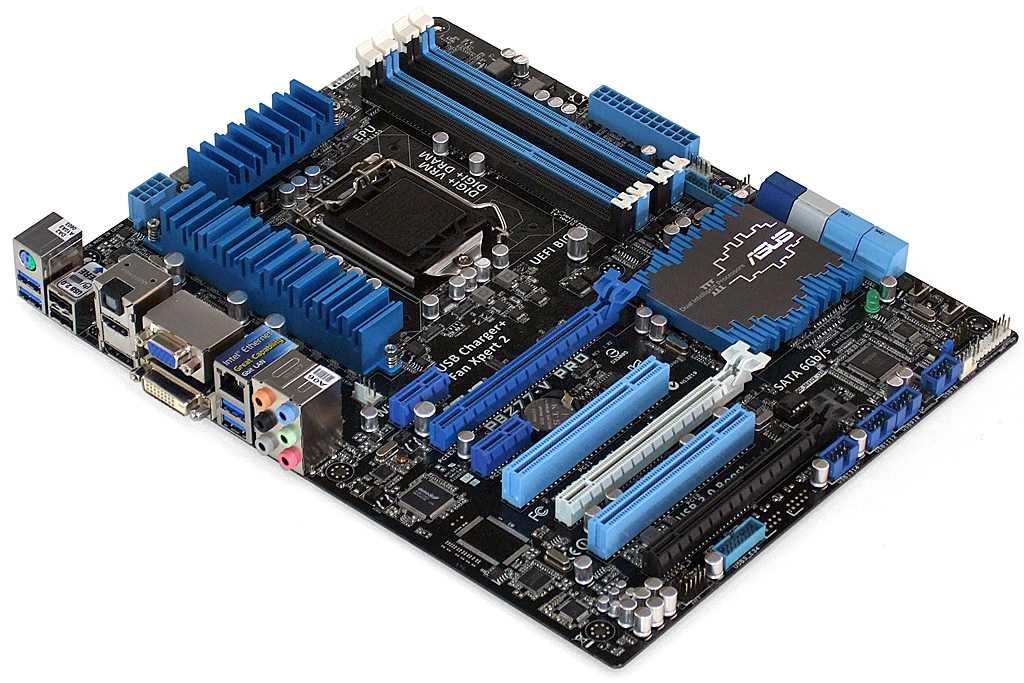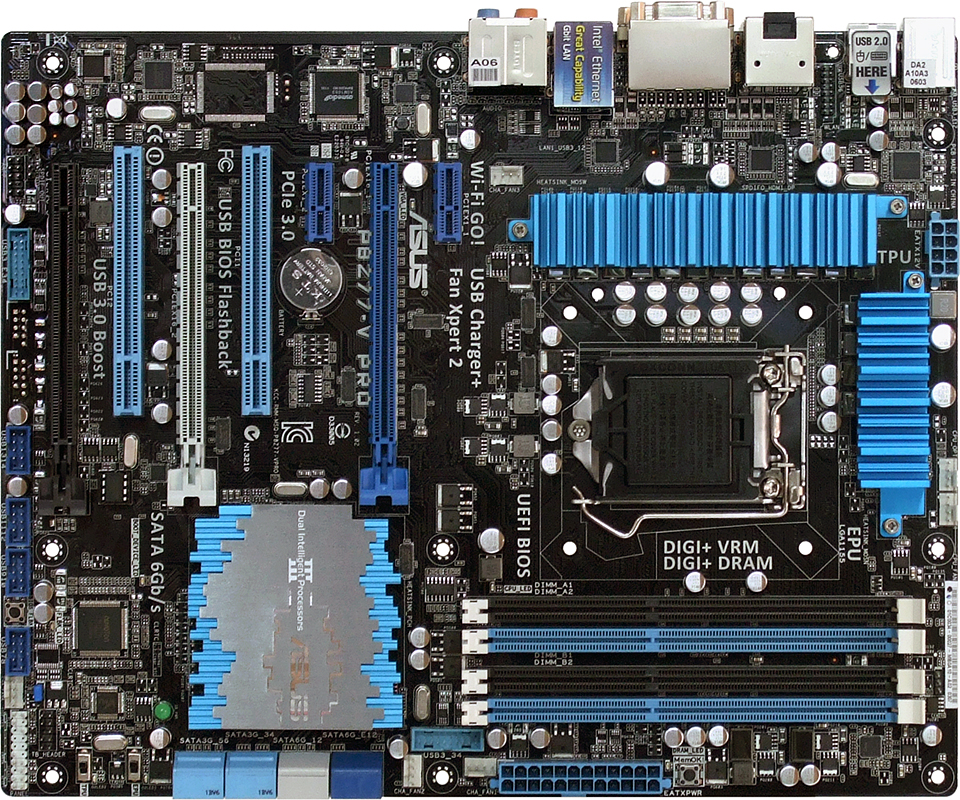Six $160-220 Z77 Motherboards, Benchmarked And Reviewed
Combining the newest features with moderate expandability, Intel’s mainstream platforms provide high value to most gaming and overclocking enthusiasts. We compare six examples with Z77 Express to find the best features, overclocking, and efficiency.
Asus P8Z77-V Pro
A $220 price that tops the mid-range enthusiast market could be justified by special features added to Asus’ P8Z77-V Pro. An I/O panel PCIe-based module adds Wi-Fi connectivity to the chipset’s native gigabit Ethernet, two added USB 3.0 controllers add four ports to those controlled by the chipset, an extra SATA 6Gb/s controller supports two extra drives, a sixteen (12+4)-phase CPU voltage controller adds stability for overclocking, an I/O panel CLR_CMOS button helps overclockers recover from ill-conceived settings, and an extra firmware ROM allows tuners to start over when resetting doesn’t work.
In a truly brilliant move, Asus retains back panel-based USB 2.0 ports specifically to address keyboard and mouse connectivity needs. Four more headers add eight ports for front-panel connectivity, and that’s in addition to the two dual-port USB 3.0 front-panel connectors.
Asus-exclusive features like MemOK, TPU, and EPU and USB BIOS Flashback are still present. MemOK temporarily underclocks memory to allow access to UEFI for manual tuning, and has come in useful for booting certain poorly-programmed modules in the past. TPU automatically overclocks the system to a preset level defined by Asus, while EPU automatically undervolts the CPU core for additional power savings. USB BIOS Flashback allows the system ROM to be updated from a flash drive using a designated port, but we also found that bumping it allowed the system to boot using a different profile.
We also find three x16-length PCIe slots, though only two of these run at PCIe 3.0 data rates through Intel's integrated Ivy Bridge-based controller. The second slot takes eight lanes from the first when a card is detected, while the third slot offers four lanes from the chipset’s PCIe 2.0 controller. Asus knows that most gaming enthusiasts will treat this as a two-way graphics design, and spaces its two primary PCIe slots three slots apart to aid GPU cooling.
Replete with (six) four-pin fan headers that each support advanced management techniques, the P8Z77-V Pro begins to look like a truly high-end product until we start noticing features that aren't present. The board, for example, lacks any diagnostics display, though it does have LEDs next to various devices to show when they’re being initiated. The lack of on-board power and reset buttons will similarly disappoint some bench-testers, though those things don’t matter once the motherboard is installed in a case. The lack of voltage detection points will cause some tuners to hunt for places to connect their meters, though Asus prefers that we trust its software readings. The long-expected FireWire controller is also missing, though most users no longer use it. And one of the added USB 3.0 internal headers would be blocked by a third graphics card, if not for the fact that most enthusiasts wouldn’t dream of putting a high-bandwidth card in a four-lane, second-gen slot.
Apparently, smart cost-cutting measures could put an otherwise high-end board into a mid-budget PC, except that any motherboard over $200 should probably include eSATA. Asus does add an eSATA/USB 3.0 breakout plate, and we’ll reserve our final thoughts on value for this article’s conclusion.
The P8Z77-V Pro’s 802.11n Wi-Fi adapter installs between the USB 2.0 and display connectors of its I/O panel, its antenna connector accessible from outside the I/O shield. Also included in the installation kit are four SATA cables, the external Wi-Fi antenna, and a two-way SLI bridge.
Get Tom's Hardware's best news and in-depth reviews, straight to your inbox.
-
yougotjaked There's a typo on the last page. It says X77H2-A2X instead of Z77H2-A2X :P It's on the second to last paragraph...Reply -
HMSvictory I am surprised that you guys did not include the Asus z77-VReply
http://www.newegg.com/Product/Product.aspx?Item=N82E16813131820 -
confish21 One thing i was looking for was the part about asrock not having true "digital" PWM and going with an analog PWM. Does this really matter?Reply -
Crashman TekN9NeGreat review! At the end of day, it comes down to brand loyalty.I don't think the article stated anything like that. It comes down to the features you want and the cards you plan to use. In the MSI vs ASRock debate, it's x8-x4-x4 with all three slots in PCIe 3.0 mode, or x8-x8-x4 with x4 in PCIe 2.0 mode, and you're definitely wiser to pick between them based on WHAT you plan to use in the third slot.simone saysdo you mean nvidia and intel gets news during weekends not only news but featured articles?It's Monday here, and editorial has very little contact with news.HMSvictoryI am surprised that you guys did not include the Asus z77-Vhttp://www.newegg.com/Product/Prod 6813131820Tom's Hardware didn't "include" anything in the review. A couple boards were excluded based on price, and everything else was let in. The P8Z77-V Pro was the cheapest board Asus sent.rickrentswhy not with Pci-e 3.0?Editor had no PCIe 3.0 cards. And the reason he didn't get one yet is because it didn't matter. The only thing that really mattered in a single-GPU MOTHERBOARD comparison was to use the same card on all platforms.confish21One thing i was looking for was the part about asrock not having true "digital" PWM and going with an analog PWM. Does this really matter?Some digital voltage regulators have been garbage, take a look at a few of the older reviews to see this. Very few have been very good. And many more analog voltage regulators have been garbage, while many more analog voltage regulators have been very good. Quality of execution is more important than the underlying technology.Reply



